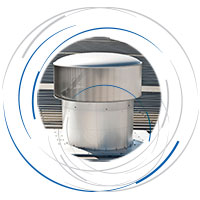EcoPower true-hybrid ventilation technology
The comfort and safety levels of building occupants are a growing concern in modern-well sealed business. The traditional means of exhausting heat or fumes from a building was either; mechanical ventilation, which has high and ongoing cost associated with it. Or turbine ventilation - though it has low ongoing cost, its performance is dependent on natural conditions such as wind.
However, Bradford Ventilation designed, engineered and manufactured EcoPower® , the world's first true-hybrid™ ventilator in Australia. EcoPower incorporates the leading design of Hurricane® vertical vane turbine ventilator with a high efficiency electronically commutated (EC) motor for reliability and on-demand peak performance, when required.
Bradford Ventilation is an ISO 9001:2008 certified manufacturer and the world leader in turbine ventilator technology.
EcoPower is designed for flexibility with three control options to choose from, perfect for a variety of applications:
1. Air iQ Customised Control options:
EcoPower with Air iQ is integrated with in-built temperature & humidity response for effective, energy efficient flow control.
The customised control options can be fully customised to your specification or, you can choose from 3 factory pre-set options.
Customised Options
1. Customised temperature only control
2. Customised humidity only control
3. Customised temperature & humidity control
or
Factory pre-set options
1. Temperature only control
2. Humidity only control
3. Temperature & humidity control
2. Building Management Controls:
EcoPower can be controlled with a 0-10V external input, for example a Building Management System (BMS).
3. EcoPower Standard controls:
On = EcoPower runs at 100% speed
Off = EcoPower runs in natural mode

